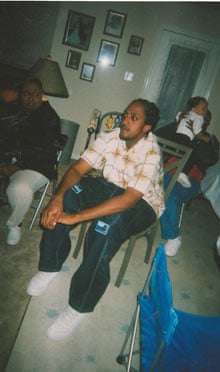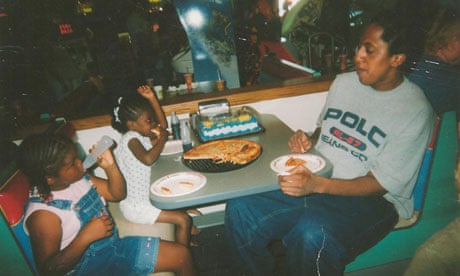Life had not been easy for Landris Hawkins, who struggled with several health problems, mental and physical. But his close-knit family in Little Rock, Arkansas, were loving, and looked after him as best they could.
His sisters, Deshuna and Levonne, called him their "gentle giant", a reference to a 6ft 7in stature caused by Marfan syndrome, a genetic growth disorder. His grandmother, Neomia, with whom he had lived since he was six, called him "Twiki", after the robot in the Buck Rogers television series they watched together when he was small.
On the afternoon of 3 November 2009, things got too much for the 28-year-old. His grandmother found him with a kitchen knife, threatening to kill himself. The sound of her voice, which was usually enough to calm him, had little effect. She called 911, hoping someone would come and get through to him or take him to hospital, where he could get help. He was too big for her to physically remove the knife, she told them, although she had tried, sustaining a cut to the hand in the process. She was still on the phone to the 911 dispatcher when police arrived.
Less than two minutes later, according to a police recording of the scene obtained by the Guardian, Hawkins lay dead, shot four times by officers from the Little Rock police department (LRPD).
Now, in the first interview she has given since that day, Neomia Hawkins, who was a clerical assistant for the Arkansas state police until she retired in March 2010, asks why officers failed to do more to help her grandson.
"I called because I thought someone would come and help me get him to the hospital," said Hawkins, 63, in the home she shares with Deshuna, Levonne and her mother, Willie, 80, Landris Hawkins' great-grandmother, surrounded by pictures of her three grandchildren. "I would never have called them if I knew …" Her words trail off.
The family, including Hawkins' mother, Nikita, remain shattered by the tragic turn of events that day. They say that despite Hawkins' intention to harm himself, the police were not justified in shooting him dead. Neomia Hawkins said:
They could have done something different. They could have tried to calm him. All they did was holler a couple of times and it was all over. I never heard them say once they had a gun. All I heard them say was 'Put the knife down'. It was all over so quick. It probably didn't take 10 minutes.
In fact, according to analysis of a video recording from the police car seen by the Guardian, only 98 seconds elapsed between the first officer arriving at the Hawkins' home and the firing of the fatal shots.
Two of the most highly charges aspects of police work, particularly in a town like Little Rock, one of the most violent in the nation, are deciding when to use deadly force and dealing with the mentally ill. Which is why the LRPD, in common with police departments across the country, has clear rules governing those situations. According to a lawsuit brought by the Hawkins family against the LRPD, officers failed to follow these rules during the brief and fatal contact they had with Landris Hawkins. It is one of three lawsuits filed against the LRPD by families whose loved ones have been shot dead by police, with what they claim is excessive use of deadly force.
The Hawkins family allege that Jason Roberts and James Christ, the first two police officers at their home that day, violated two LRPD general orders. The first, GO 303, on the deadly use of force, forbids officers from firing inside a building "unless the officer or someone else is drawing deadly fire and the suspect can be identified and is clearly visible".
The other order, GO 309, governs how to deal with the mentally ill and advises officers: "Avoid excitement, confusion, or upsetting circumstances. These may frighten the person, inhibit communications, and increase the risk of physical injury to the subject, the officer or other persons." It further advises: "With an image of quiet self-assurance and an insistence on your orders being followed, gently indicate that your only intention is to help the person."
'We're going to have to shoot him'
Witness testimony and mobile video recorder (MVR) footage shot from police cars at the scene point to a highly-charged situation in which officers shouted orders at Hawkins though a glass door, failed to give any assurances or warnings and quickly shot him dead.
Footage from the MVR on Roberts' car, which was parked outside the house, shows that officers drew up at the Hawkins home in three cars, arriving in quick succession, all with flashing lights and sirens blaring. According to Willie Hawkins, they arrived at the porch door of the house on Carlyle Avenue with their guns drawn.

When they arrived, Landris Hawkins was leaning against a wall inside the house with a knife at his throat, according to his grandmother, who was about a foot away. After establishing that she was unhurt, the officers asked her to leave the house. She refused, telling them she had a baby, Hawkins' nephew Deandre, in her arms. Neomia Hawkins could not see the officers but she could see her grandson. She did not leave, because, she said, by then she was afraid the police would shoot and she or the baby would be hurt. She was also reluctant to leave her grandson.
The officers' interaction with Landris Hawkins, according to the MVR, involved them shouting at him through a glass storm door to "put the knife down" a total of 11 times, twice adding "I mean it" or "I'm not telling you again".
In a particularly chilling exchange, Roberts tells Christ "Jimmy, I don't have a choice" and the two agree: "We're going to have to shoot him." Then the fatal shots ring out.
"What the officers did that day would seem to reflect a complete misunderstanding of police protocol," said the Hawkins family's lawyer, Michael Laux.
It would seem that they did precisely what they are not supposed to do. You don't rush the person, you don't threaten them. You talk them down.
Neomia Hawkins, who said she did not see her grandson react to the officer's commands, believes there was a chance he was not even aware of them. He had poor eyesight and required thick glasses, which he was not wearing that day. His hearing was also bad, another consequence of Malfan's syndrome, she said.
"If he heard them he didn't give any reaction. He never moved the whole time. He might have slid over a little bit but he never moved his feet. He didn't really move until they shot him and then he stumbled and then they shot him again," she said. "But he never tried to hurt anyone but himself."
The family allege that at no point did officers enter the home, address Hawkins by name or give any warning to him, his grandmother or great-grandmother that they had guns or would shoot.
According to their federal lawsuit, Christ said he believed Hawkins presented a threat to himself, to the others in the house and to the officers themselves. Roberts said he believed Hawkins presented a threat to others in the house. They said he was pacing around and when his behaviour changed and he became more agitated, they shot him.
On the video recording, Willie Hawkins, who had gone into the yard, can be heard telling the officers "there's something wrong with him" and "there's something wrong with his mind". The officers do not appear to acknowledge her.
"I was telling them not to shoot him," she said. "I was telling them there's something wrong with him. He was trying to kill himself, he wasn't hurting anyone else but they weren't paying any attention. It will never leave me. I'm 80 years old and I will take that to my grave."



Comments (…)
Sign in or create your Guardian account to join the discussion